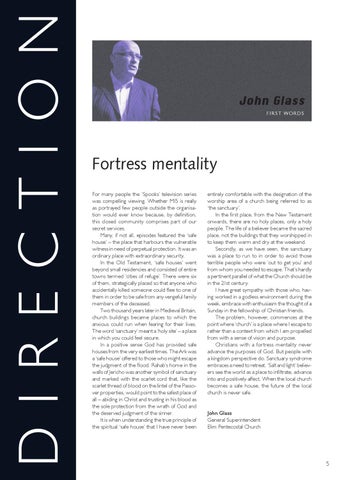DIRECTION
F I R S T WO R D S
Fortress mentality For many people the ‘Spooks’ television series was compelling viewing. Whether MI5 is really as portrayed few people outside the organisation would ever know because, by definition, this closed community comprises part of our secret services. Many, if not all, episodes featured the ‘safe house’ – the place that harbours the vulnerable witness in need of perpetual protection. It was an ordinary place with extraordinary security. In the Old Testament, ‘safe houses’ went beyond small residencies and consisted of entire towns termed ‘cities of refuge’. There were six of them, strategically placed so that anyone who accidentally killed someone could flee to one of them in order to be safe from any vengeful family members of the deceased. Two thousand years later in Medieval Britain, church buildings became places to which the anxious could run when fearing for their lives. The word ‘sanctuary’ meant a ‘holy site’ – a place in which you could feel secure. In a positive sense God has provided safe houses from the very earliest times. The Ark was a ‘safe house’ offered to those who might escape the judgment of the flood. Rahab’s home in the walls of Jericho was another symbol of sanctuary and marked with the scarlet cord that, like the scarlet thread of blood on the lintel of the Passover properties, would point to the safest place of all – abiding in Christ and trusting in his blood as the sole protection from the wrath of God and the deserved judgment of the sinner. It is when understanding the true principle of the spiritual ‘safe house’ that I have never been
entirely comfortable with the designation of the worship area of a church being referred to as ‘the sanctuary’. In the first place, from the New Testament onwards, there are no holy places, only a holy people. The life of a believer became the sacred place, not the buildings that they worshipped in to keep them warm and dry at the weekend. Secondly, as we have seen, the sanctuary was a place to run to in order to avoid those terrible people who were ‘out to get you’ and from whom you needed to escape. That’s hardly a pertinent parallel of what the Church should be in the 21st century. I have great sympathy with those who, having worked in a godless environment during the week, embrace with enthusiasm the thought of a Sunday in the fellowship of Christian friends. The problem, however, commences at the point where ‘church’ is a place where I escape to rather than a context from which I am propelled from with a sense of vision and purpose. Christians with a fortress mentality never advance the purposes of God. But people with a kingdom perspective do. Sanctuary syndrome embraces a need to retreat. ‘Salt and light’ believers see the world as a place to infiltrate, advance into and positively affect. When the local church becomes a safe house, the future of the local church is never safe. John Glass General Superintendent Elim Pentecostal Church
5
